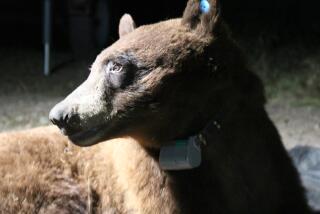Bears, Drivers at Deadly Crossroads
- Share via
FILLMORE — California black bears will do almost anything for honey--even brave a four-lane highway or crash through an electric fence.
But it wasn’t the sweet nectar that caused a 400-pound bear to dart in front of a semitruck just east of Fillmore early Wednesday--a crash that killed the bear instantly.
Recent brush fires have obliterated bears’ natural habitat and left them foraging for food, water and new places to call home, often in areas closer to human settlements, according to state and local officials.
“Bears prefer to be in the hills where they can forage, but when the area burns, they will look for anything they can find,” said Red Bennett, owner of Red Bennett’s Honey Farm in Fillmore.
California black bears generally like to feast on wild berries, plants and roots, according to Bennett and wildlife officials, but when fires destroy their natural grocery store, hunger drives them to move closer to civilization in search of sustenance, including avocados and citrus.
Bennett puts his few thousand honey colonies behind electric fences to keep them safe from bears. Despite such deterrents, when bears get desperate they are willing to suffer numerous bee stings and a mild electric shock just to get their hands sticky with fresh honey.
“Crashing through an electric fence is not something a young, healthy bear is going to endure to get to a free lunch,” said Bennett, who lost 15 bee colonies to bears last month. “It is normally a very old bear that is losing his teeth and not able to forage in a normal manner that gets into the beehives.”
Hives or no hives, bears in the east part of the county are moving around these days, and sometimes they get in the way of vehicles traveling at high speeds.
The male bear that was killed at 5:30 a.m. Wednesday was probably not in search of honey, according to Bennett, because bee colonies are not harvested in the late summer.
“Who knows why this bear crossed the road,” said Patrick Moore, spokesman for the California Department of Fish and Game. In response to a question about whether the bear was heading to the Santa Clara River for water, he said, “there is plenty of water on that side of the road as well.”
Larry Sitton, a senior biologist with the department, said four bears have been killed on California 126 in the past four months, but that the number is not alarming. “At this point in time it is a totally normal occurrence,” he said. “If we start getting more, like four or five more in a three- or four-week period, we’ll start scratching our heads.”
Ramon Vega manages the citrus and avocado ranch near where Wednesday’s accident occurred. He said two of the last four bears killed in Ventura County have died on or near the 400-acre Santa Clara Ranch.
Vega said the ranch has learned to get along peacefully with bears.
“They do some damage, but we tolerate them,” he said. “They come and eat the fruit, but you can’t put up fences, because they’ll just do what they want. They don’t mess with us and we don’t mess with them.”
The truck’s 58-year-old driver, Jerry Boles of Sanger, Calif., suffered minor injuries and was taken to Simi Valley Hospital.
“The truck was like a pretzel, it was like somebody twisted it,” said Vega, who helped Boles get out of the truck’s cab. “It is amazing to see a semi in the middle of my orchard because of a bear.”
Boles was traveling about 60 mph in a truck half full of agriculture feed when the bear stepped in front of his vehicle, according to the California Highway Patrol.
“He had no time to react and lost control,” said CHP spokesman Dave Cockrill.
More to Read
Sign up for Essential California
The most important California stories and recommendations in your inbox every morning.
You may occasionally receive promotional content from the Los Angeles Times.










